Slow meteors are studied with video observations and spectroscopy. A comparison of their orbits and spectra points to a common origin. Although they do not belong to some meteor stream, they deserve to be studied in more detail. The present paper tries to make a first attempt to characterize the common properties of this class of meteors.
1 Introduction
In a previous paper (Dubs et al., 2017) we studied two slow meteors with very similar orbits. Having some more observations of slow meteors with a similar spectrum we started looking more closely for slow meteors. As our meteor group has been collecting data for over two years we searched our database of video meteor observations for similar meteors. Using the velocity vg (geocentric velocity corrected for Earth gravitation) as a selection criterion we found a sufficient number in our database for a study of their properties. A connection of these meteors with near Earth asteroids belonging to the Apollo family is postulated.
2 Two case studies
M20170327_234523
This meteor was recorded by 12 cameras at 8 stations of the FMA meteor network. Data from 7 stations were used for the trajectory (Figure 1).
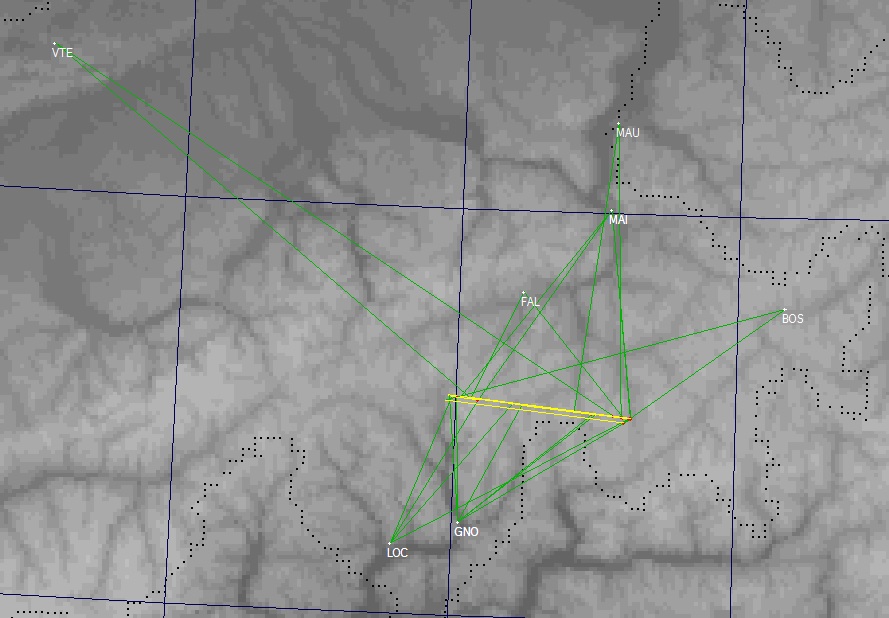
Figure 1 – Trajectory of M20170327_234523, calculated with UFO Orbit.
The velocities v0 calculated by UFO Orbit for the different observers were between 11.0 and 12.8 km/s with an average velocity of 12.56 km/s, resulting in a geocentric velocity vg of 6.25 km/s after correction for terrestrial gravitation. An independent calculation by Beat Booz, including detailed analysis of the deceleration of the meteor gave slightly higher values for the meteor velocity (v0 = 13.8 km/s and vg = 8.56 km/s)[1]. These calculations also resulted in the meteoroid orbit elements (see Table 1).
The meteor crossed the field of view of a spectroscopic video camera at one station (Maienfeld, Watec 902H2 ultimate, f = 8mm, F/0.95, grating 600 L/mm, Figure 2).
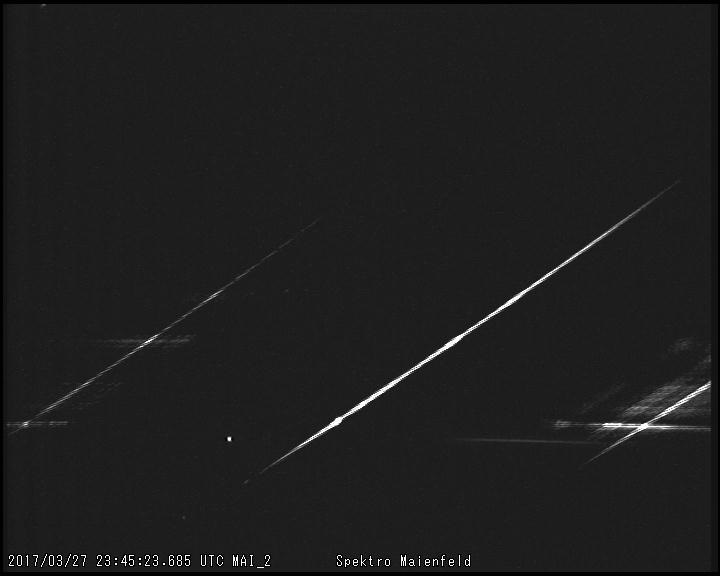
Figure 2 – Spectrum of M20170327_234523, recorded at Maienfeld.
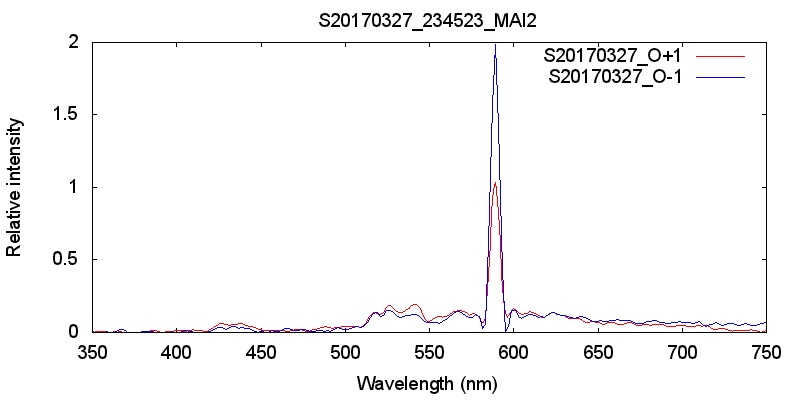
Figure 3 – Calibrated spectrum of M20170327_234523, red: 1st order, blue: –1st order, not corrected for instrument response.
The video spectrum was extracted and analyzed as described in (Dubs and Maeda, 2016). After linearization, stacking and calibration both the first order and the negative first order (on the left of the zero order) could be extracted (see Figure 3).
The saturation of the strongest line (Na I) is visible in the first order spectrum (much lower intensity than the corresponding line in the –1st order). The Mg- and Fe-lines (only partially resolved) are weak, similar to the spectrum of M20170102_015202, which was reported earlier (Dubs et al., 2017).
M20160809_001015
This meteor was found while looking through the database for slow meteors with long duration. It was observed by four stations with a total of 7 cameras, and a precise determination of the flight path was possible. Maximum observed duration was 10.5 s, with a small entrance angle into the atmosphere (Figure 4).
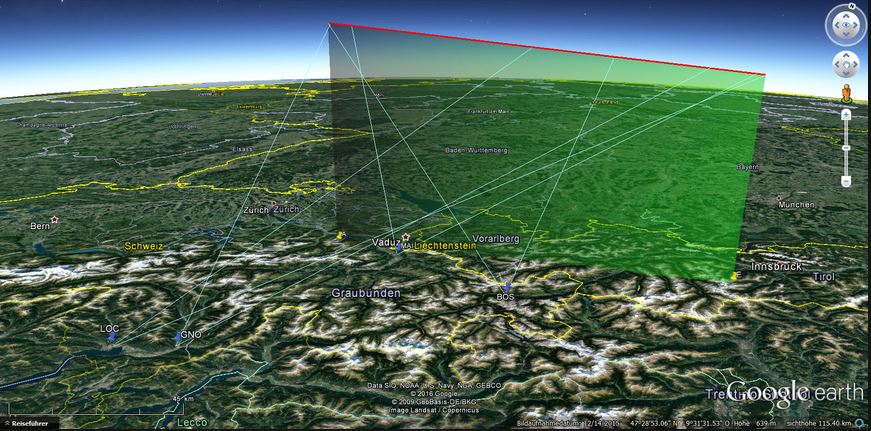
Figure 4 – Observed trajectory of M20160809_001015, 3-D visualization in Google Earth.
The velocities v0 calculated by UFO Orbit for the different observers were between 12.1 and 14.5 km/s with an average velocity of 13.59 km/s, resulting in a geocentric velocity vg of 8.28 km/s after correction for terrestrial gravitation. The calculation of Beat Booz gave similar results (v0 = 13.32 km/s, vg = 7.91 km/s, no deceleration determined).
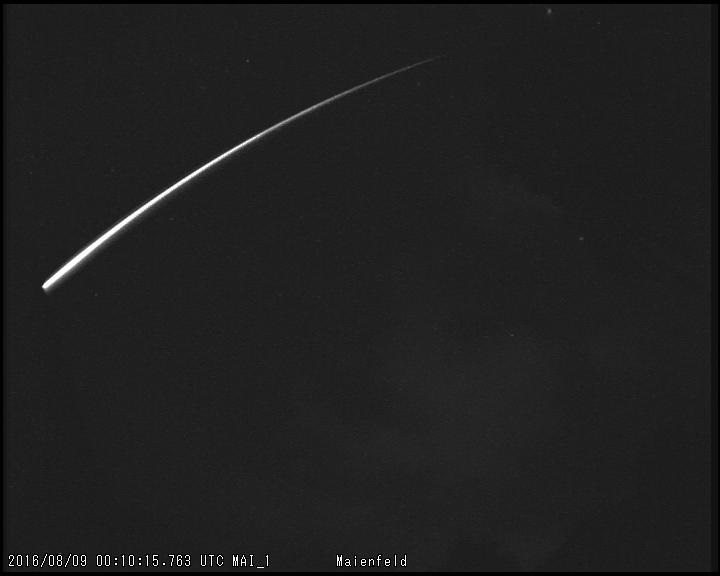
Figure 5 – Peak image of M20160809_001015, recorded at Maienfeld.
The orbit calculation by Beat Booz shows that the meteoroid passed close to Mars, with a minimum distance of 0.0199AU before arriving at the Earth. The minimum distance is not very precisely calculated, small errors in the velocity or radiant direction may change the orbit significantly, but one may speculate about a connection. For a significant change of the meteoroid orbit by the gravitation of Mars the calculated distance was too large[2].
Unfortunately, the meteor was outside the field of view of all spectral cameras, therefore no spectrum is available for this meteor and no hint about the chemical properties of the meteor is possible.
Orbital elements
In order to complete this section about the observations, the orbital elements for these two meteors are given.
Both orbits have very low inclination and a perihelion distance close to 1 AU, osculating the Earth orbit with an aphelion distance in the asteroid belt, as shown in Figure 6. This will be discussed further in the next section.
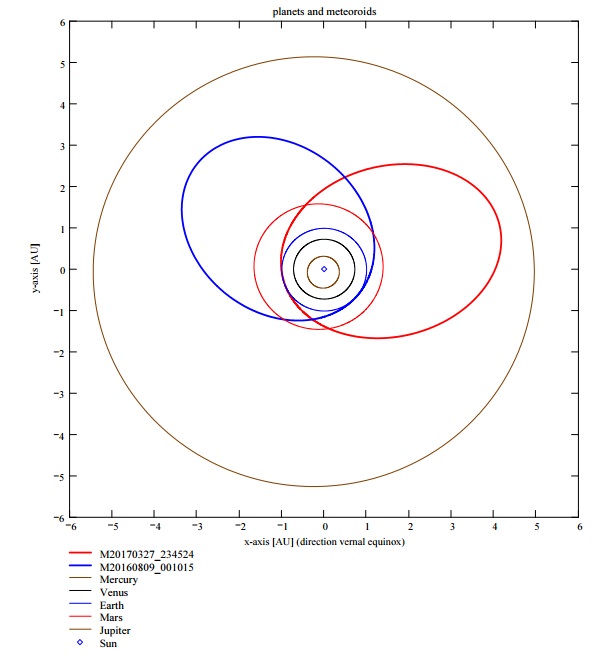
Figure 6 – Orbits of M20170327__234523 and M20160809_001015.
Table 1 – Orbital elements.
| Meteor | 20170327 | 20160809 |
| a | 2.6996 | 2.4667 |
| q | 0.9943 | 1.0137 |
| e | 0.6317 | 0.589 |
| P(eriod) | 4.4355 | 3.8741 |
| ω | 187.25 | 4.45 |
| Ω | 8.12 | 313.60 |
| incl. | 0.21 | 0.09 |
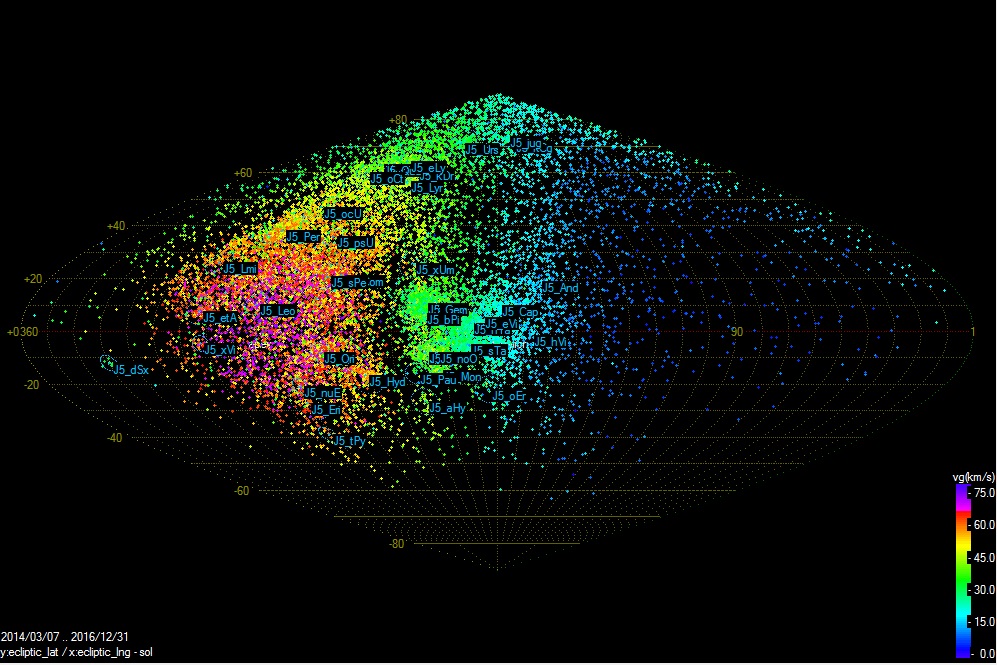
Figure 7 – Unified radiants of meteors observed by FMA until 31.12. 2016, plotted as a function of (eclipical longitude – sol) and latitude.
3 Database search for slow meteors
The Swiss meteor observation network of the FMA (Fachgruppe Meteorastronomie) is in operation since 2014 and covers most of Switzerland’s sky and the neighboring regions with 47 cameras, located at 13 stations. During this time (3.4.2014 – 31.12 2016), 208791 meteors were observed, from which 26120 unified meteor orbits could be determined with UFO Orbit. The radiants of these meteors are shown in Figure 7.
For the following analysis the range of observations was restricted to the years 2015 and 2016, since during the first year the stations operated in a less reliable test phase. This reduced the number of observed meteors to 189530 with 25344 unified meteor orbits. The meteor data were uploaded regularly to the database server and analyzed and published on the FMA website after the end of each month[3].
UFO Orbit does not allow plotting the meteors within a specified velocity range, so a file containing all the orbit data of the unified meteor orbits was exported and further processed in an EXCEL worksheet. In this file the meteors within a range of geocentric velocities 0 < vg < vg(max) were selected. All meteor streams have vg > 15 km/s, therefore choosing a smaller value for vg(max) excludes all meteors belonging to known streams. Reducing the value further also excludes many sporadic meteors. The number of meteors depends on the value of vg(max), but it is still large enough for a statistical analysis. For vg(max) = 9 km/s, the number of meteor orbits is reduced to 254, or 1% of the complete sample. This may look unimportant, but it includes some prominent meteors, e.g. the largest fireball observed from Switzerland and Germany of the last two years on March 15, 2015, which probably landed in the Swiss Alps[4]. The radiants of these meteors are plotted in Figure 8.
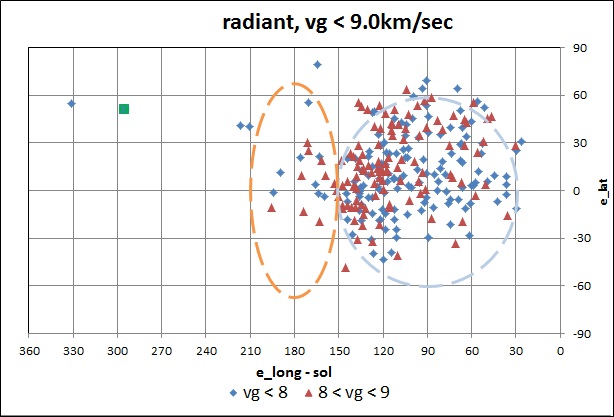
Figure 8 – Radiants of slow meteors in ecliptical coordinates (longitude – sol), corrected for zenithal attraction (green square dot: 15.3.2015 fireball).
The large scatter of the points does not indicate a close similarity of the orbits. However two groups can be distinguished, with some meteors not belonging to any group:
- The antihelion source centered around e_long – sol = 180° (± 30°)
- A diffuse source centered on e_long – sol = 90° (with a cone angle of approximately 60°); in the following called anti-apex source.
The antihelion source is well known (Rendtel, 2014). It consists of mainly small meteoroids in Earth-similar-orbits with small eccentricity, originating from asteroid collisions and which subsequently drift onto smaller orbits, e.g. caused by the Poynting-Robertson effect (Williams, 2002). This will not be discussed any further here.
The anti-apex source is not specifically mentioned in the meteor literature and therefore it will be discussed here in some detail. The anti-apex is the direction opposite to the Earth orbital velocity (ve). The heliocentric meteoroid velocity must therefore be larger in order to catch up with the Earth orbital motion: ve < vh < ve + vg(max). Neglecting the eccentricity of the Earth orbit this gives limits for the semi-major axis (a) of the meteoroid orbit. In order to eliminate meteoroid orbits close to Jupiter we chose vg(max) < 8.7 km/s, which results in an aphelion distance Q < qJup = 4.95 AU, using the relation (Porter, 1952):

Figures 9 and 10 show the calculated orbital elements for these meteoroids with 30° < e_long – sol < 150° and vg < 8.7 km/s.
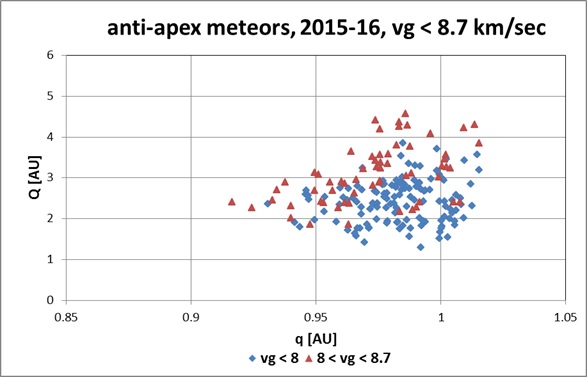
Figure 9 – Aphelion vs. perihelion distance of slow anti-apex meteoroids.
As expected, the perihelion distances are smaller than Qe = 1.014 AU (aphelion distance of Earth) with fairly low inclination < 12°, limited by a vector addition of vg and vh to values < 12.8° for a cone angle of 60°. These orbits correspond to Apollo asteroid orbits (a > 1, q < 1.014, Binzel et al., 2015). Aphelion distances Q of the meteoroids are smaller than qJ. Without going into the details of calculation, the probability of a collision between the meteoroid and the Earth is roughly proportional to the length of the overlapping region and the capture cross section. The length of the intersection region is largest for meteoroid orbits with q ~ 1 and low inclination, crossing the Earth orbit at a very small angle. In addition, for low velocity vg the capture cross section increases by a factor (v0/vg)^2 compared to fast meteors, because slow meteors are accelerated towards the Earth by gravitation (this can easily be calculated by the angular momentum conservation, the interception distance r * vg is equal to R * v0 for an Earth grazing meteor, with R: radius of Earth plus atmosphere, v0 ≥ 11.2 km/s). In other words, slow anti-apex meteoroids have a high probability of being captured by collisions with the Earth.
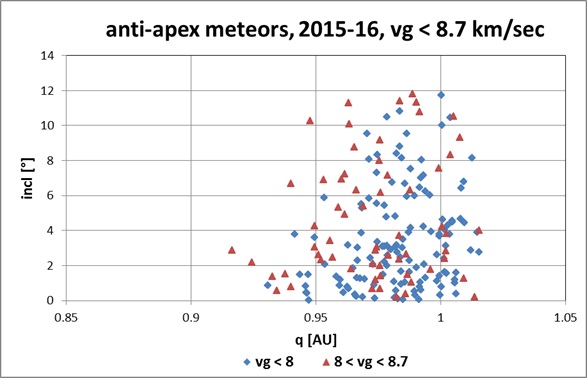
Figure 10 – Inclination vs. perihelion distance of slow anti-apex meteoroids.
During the year the number of slow meteors varies in a similar way to the number of sporadic meteors (see Figure 11). This includes the effects of length of the night and weather (quite often the weather is only good on only one side of the Alps, which reduces the number of observed meteors during these times). In addition the height of the anti-apex is highest during the winter months for an observer at northern latitudes, which is not really reflected in the data. On the other hand, it remains to be seen if the relative large number of slow meteors between sol 30°–60° and 330°–360° is just a statistical fluke.
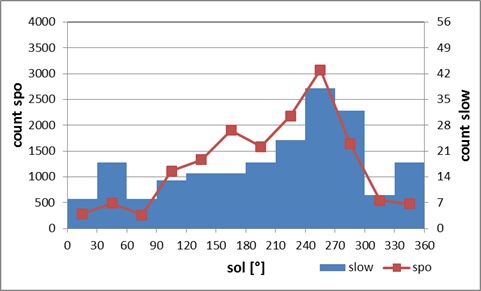
Figure 11 – Frequency of slow (vg < 8.7 km/s) anti-apex meteors compared to sporadic meteors vs. solar longitude.
4 Discussion
A connection between near Earth asteroids (NEA) and meteorites has been postulated by Binzel et al. (2015) and Borovička et al. (2015). It has been shown in the present study that slow anti-apex meteors have orbits similar to Apollo asteroids. Therefore it seems a reasonable assumption that these meteors are fragments of Apollo asteroids, produced in collisions with other asteroids or meteoroids. Unfortunately a direct connection to a parent body such as in asteroid families is difficult because the orbits of these meteoroids are not well enough known. Small variations in observed velocities v0 produce larger errors of vg, the velocity error of vg is a factor v0/vg larger than the error of v0. In addition, zenith attraction increases rapidly also for slow vg, making the determination of the radiant unreliable. The appearance of slow anti-apex meteors at any time of the year indicates that not a single parent body can be responsible. On the other hand, the small entrance velocity v0 < 15 km/s increases the chances for the survival of the meteoroid in the atmosphere, with some fragment arriving on the ground. The orbit of M20160809_001015 demonstrates that a meteoroid from Mars cannot be excluded. However it seems unlikely, as it would have to traverse the Martian atmosphere and need a sufficiently large initial velocity to leave the gravitational field of Mars. An asteroid origin seems much more probable. So far we have not been successful recovering a meteorite with a recorded flight path, but this is the goal as well as to record a spectrum, such as for the Benešov fireball (Borovička, 2016). Planned extensions of our network of video cameras, some equipped also for spectroscopic recordings, enhance the chances for a future detection and recovery of a meteorite. This may complement experiments such as OSIRIS-REx, which will return samples from asteroid Bennu in 2023 (Lauretta et al., 2017). As an amateur organization we cannot afford a satellite and a low cost project is important and hopefully we succeed before that date with finding a meteorite.
Acknowledgment
The following members of the Swiss FMA (Fachgruppe Meteorastronomie) contributed with their observations to the present study: Andreas Buchmann (ALT, BAU), Jochen Richert (BOS), Stefan Meister (BUE, EGL), José De Queiroz (FAL), Hansjörg Nipp (MAU) and Fredi Bachmann (OBE). Jonas Schenker presented and collected the data on our website.
References
Binzel R. P., Reddy V. and Dunn T. (2015). “Near Earth Object Population”. In Michel P., DeMeo F.E. and Bottke W. F., editors, Asteroids IV, pages 243–256.
Borovička J., Spurny P and Brown P. (2015). “Small Near-Earth Asteroids as a source of Meteorites”. In Michel P., DeMeo F. E. and Bottke W. F., editors, Asteroids IV, pages 257–280.
Borovička J. (2016). “Photographic spectra of fireballs”. In Roggemans A. and Roggemans P., editors, Proceedings of the International Meteor Conference, Egmond, the Netherlands, 2 – 5 June 2016. IMO, pages 34–38.
Dubs M. and Maeda K. (2016). “Calibration of Meteor Spectra”. In Roggemans A. and Roggemans P., editors, Proceedings of the International Meteor Conference, Egmond, the Netherlands, 2 – 5 June 2016. IMO, pages 65–68.
Dubs M., Sposetti S., Spinner R. and Booz B. (2017). “Two slow meteors with spectra”. eMeteorNews, 1, 4–8.
Lauretta D. S., Balram-Knutson S. S., Beshore E., Boynton W. V., Drouet dAubigny C., DellaGiustina D. N., Enos H. L., Gholish D. R., Hergenrother C. W., Howell E. S., Johnson C. A., Morton E. T., Nolan M. C., Rizk B., Roper H. L., Bartels A. E., Bos B. J., Dworkin J. P., Highsmith D. E., Lorenz D. A., Lim L. F., Mink R., Moreau M. C., Nuth J. A., Reuter D. C., Simon A. A., Bierhaus E. B., Bryan B. H., Ballouz R., Barnouin O. S., Binzel R. P., Bottke W. F., Hamilton V. E., Walsh K. J., Chesley S. R., Christensen P. R., Clark B. E., Connolly H. C., Crombie M. K., Daly M. G., Emery J. P., McCoy T. J., McMahon J. W., Scheeres D. J., Messenger S., Nakamura-Messenger K., Righter K. and Sandford S. A. (2017). “OSIRIS-REx: Sample Return from Asteroid (101955) Bennu”. eprint arXiv: 1702.06981. 89 pages.
Porter J. G. (1952). “Comets and Meteor Streams”, page 88.
Rendtel J. (2014). “Meteor Shower Workbook”. IMO.
Williams I. P. (2002). “The Evolution of Meteoroid Streams”. In Murad E. and Williams I.P., editors, Meteors in the Earth’s Atmosphere, pages 13–32.
[1] Results of UFO Orbit analysis of the data from the FMA network: http://www.meteorastronomie.ch/ergebnisse_sonotaco.html
[2] For a detailed study of this meteor see: http://www.meteorastronomie.ch/detaildatafk.php?id=25
[3] The detailed observations and the calculation, including an animated view of the trajectory of the meteoroid in the solar system can be found at: http://www.meteorastronomie.ch/detaildatafk.php?id=75.
[4] Further details on the calculation, images and videos of the meteor can be found on our website at http://www.meteorastronomie.ch/detaildatafk.php?id=80.





